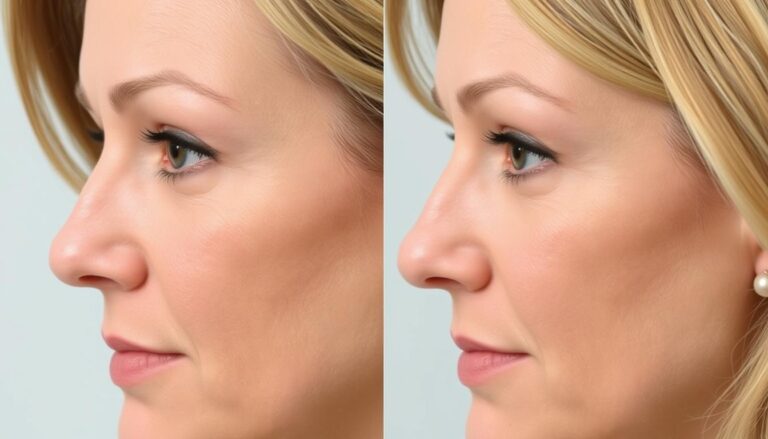Mounjaro Before and After Results Explained

Did you know that Mounjaro can help patients lose about 1% of their body weight each week in the first four weeks? This means they can lose around 1kg every week. It’s known as tirzepatide and is famous for helping with type 2 diabetes and weight loss. People using it have lost an average of 11% of their weight by four months and up to 21% after a year.
This article looks at the amazing changes Mounjaro has brought to people’s lives. We’ll share real-life Mounjaro before and after stories from patients. You’ll learn how it works, who it’s best for, and what to do before, during, and after treatment. This could help you decide if Mounjaro is right for your weight loss journey.
Table of Contents
What is Mounjaro Treatment?
Mounjaro, also known as tirzepatide, is a new treatment for type 2 diabetes and weight loss. It’s an FDA-approved injectable made by Eli Lilly. It helps control blood sugar levels effectively.
Overview of Mounjaro
Mounjaro is used to treat type 2 diabetes and help with weight management. It works by improving insulin resistance and reducing hunger. This makes it a good choice for those who want to control their blood sugar and lose weight.
How Mounjaro Works
Tirzepatide mimics incretin hormones GLP-1 and GIP. These hormones help regulate insulin and hunger. Mounjaro improves blood sugar levels and aids in weight loss. People may see results within hours or days after starting it.
Benefits of Mounjaro
Mounjaro offers more than just blood sugar control. Studies show it can lead to significant weight loss, with an average of 19.5% to 20.9% over time. It helps improve overall health without needing big lifestyle changes. Its ability to manage glucose and weight makes it a comprehensive treatment.
| Feature | Mounjaro (Tirzepatide) | Ozempic (Semaglutide) |
|---|---|---|
| FDA Approval | Spring 2022 | 2017 |
| Weight Loss Average (72 weeks) | 19.5% to 20.9% | Up to 15% |
| A1C Reduction | Lowered HbA1c up to 1% above insulin glargine | Lowered HbA1c by 1% |
| Initial Dosage | 2.5 mg weekly | 0.25 mg weekly |
Who Needs Mounjaro Treatment?
Mounjaro is for people with type 2 diabetes and weight issues. Knowing who it helps makes treatment better. Here are some important points.
Ideal Candidates
Adults with type 2 diabetes can benefit from Mounjaro. It helps manage blood sugar levels. People with obesity, especially those with health problems due to their weight, also find it helpful.
It can lead to better health and weight management.
Conditions Treated
Mounjaro treats type 2 diabetes and obesity. Studies show it helps people lose more weight than traditional treatments like Ozempic. It’s becoming a key option for managing obesity.
Consultation with a Provider
Getting a Mounjaro consultation with a doctor is crucial. They look at your health history and concerns. This ensures the treatment fits your health goals.
The Procedure for Mounjaro
The Mounjaro procedure has several steps designed for effective treatment. Knowing these steps helps patients get ready physically and mentally.
Steps of the Treatment
The Mounjaro process starts with a first meeting. Healthcare experts check individual needs and plan a dosage. Patients start with weekly injections of 2.5 mg.
Doses may go up based on how the body reacts. This helps get the best results.
Duration of the Procedure
The Mounjaro treatment is not fast. It involves weekly injections for a long time, often up to a year. This lets the body adjust to the medication.
What to Expect During Treatment
Patients will go through an adjustment period during treatment. Some might feel a bit sick, like nausea. They will also have regular check-ups.
These check-ups help doctors adjust the treatment plan. For more on men’s health, check out this resource on men’s health exercises.
Pre-Treatment Care for Mounjaro
Before starting Mounjaro treatment, it’s key to prepare well. This prep can make your treatment more effective and smoother. Knowing the right steps will help you get ready for your Mounjaro appointment.
Preparing for Your Appointment
It’s important to gather your medical history and list all current medications. Being open about your health goals helps your provider create a treatment plan that fits you.
Necessary Lifestyle Changes
Making healthy lifestyle changes can boost Mounjaro’s effects. Eating better and exercising regularly are key. These steps prepare your body for treatment and help you reach your weight loss goals.
Medications to Avoid
Some meds can make Mounjaro less effective. Tell your doctor about all your medications, including over-the-counter and herbal ones. GLP-1 receptor agonists might need to be adjusted or stopped for your treatment.
Following these steps helps prepare for your Mounjaro appointment and sets you up for success. For more on staying healthy and sleeping well, check out lifestyle changes that can improve your experience.
Before and After Treatment Pictures
Seeing the results of Mounjaro treatment is key to understanding its impact. Pictures of Mounjaro before and after can really motivate people on their weight loss path. These images show off personal victories and help set realistic goals for weight loss.
Importance of Visual Evidence
Seeing Mounjaro’s effects can really boost motivation and keep people on track. Many find comfort in seeing how far they’ve come. Before and after photos share real stories and help others think about their choices.
Sources for Authentic Images
Finding true Mounjaro before and after photos is important. You can find them in:
- Online support groups where users share their stories.
- Clinical trial publications that show results.
- Healthcare provider websites with real testimonials.
Looking at these sources not only shows the effects of Mounjaro. It also creates a community for those thinking about or already on Mounjaro treatment.
Post-Treatment Care for Mounjaro
Starting your recovery with Mounjaro smoothly means following the right care steps. It’s important to know how long it takes to recover and use the products suggested. Also, being aware of possible issues helps keep you safe and comfortable.
Recovery Timeframe
Recovering from Mounjaro takes time, with most people feeling better as they adjust. Side effects like nausea and stomach pain usually go away in a few days. Losing weight can keep going, showing progress for weeks.
Recommended Aftercare Products
Using the right products can make your recovery better. Here are some helpful ones:
- Metabolism-boosting supplements to keep weight loss going.
- Hydrating skin care to soothe any irritation at the injection site.
- Probiotics for better gut health and to handle stomach side effects.
- Gentle cleansers to keep your skin clean and help it heal.
Signs of Complications
Even though most people recover well, it’s key to watch out for signs of trouble. If you notice severe stomach pain, can’t keep food down, or have ongoing nausea and vomiting, get help right away. Knowing these signs can help you get the care you need quickly.
Risks Associated with Mounjaro
Mounjaro is good for managing type 2 diabetes but comes with risks. It’s important to know these risks to make smart choices about treatment. Also, knowing when to get medical help is key.
Common Side Effects
Many people taking Mounjaro face common side effects. These are mostly stomach-related issues. Here are some:
- Nausea
- Vomiting
- Diarrhea
- Decreased appetite
- Constipation
- Abdominal pain
These side effects can be uncomfortable but usually get better over time. Mild issues like indigestion and bloating are also common but don’t last long.
Rare but Serious Risks
While rare, serious risks with Mounjaro need attention. These include:
- Pancreatitis
- Severe digestive problems
- Hypoglycemia, especially with other diabetes meds
- Gallbladder disease
- Increased risk of thyroid cancer, like medullary thyroid carcinoma (MTC)
- Severe allergic reactions
Signs of thyroid cancer include hoarseness, neck lumps, and trouble swallowing. If you have a family history of MTC, talk to your doctor before starting Mounjaro.
Products to Use Pre and Post Mounjaro
After getting Mounjaro treatment, picking the right products is key for skin health and wellness. A good Mounjaro skincare routine can help with any irritation from injections and aid in recovery. This part talks about skincare tips and supplements that are good for your Mounjaro journey.
Skincare Recommendations
For the best recovery after treatment, use gentle and nourishing products. Here are some good choices for your Mounjaro skincare routine:
- Soothing creams with aloe vera or hyaluronic acid to calm the skin.
- Gentle cleansers that won’t irritate sensitive areas, especially where injections were given.
- Moisturizers that nourish and help keep the skin hydrated and protected.
Supplements to Boost Results
Adding certain supplements can make Mounjaro treatment even better. Think about these:
- Omega-3 fatty acids for heart health and to reduce inflammation.
- Multivitamins to make sure you get all the nutrients you need and support health during weight loss.
- Fiber supplements to help control hunger and keep your digestive system healthy.
Alternative Treatments to Mounjaro
Looking into weight loss and blood sugar control? Knowing about Mounjaro alternatives is key. Many treatments are out there, each with its own benefits and results. Comparing them can help you choose the best option for you.
Comparing Other Weight Loss Treatments
Several medications are like Mounjaro in helping with weight loss. Here are some notable ones:
- Ozempic: This drug is another GLP-1 receptor agonist but might not work as well for weight loss as Mounjaro.
- Wegovy: It’s made for weight loss and uses the GLP-1 mechanism but could have different effects.
- Saxenda: It’s for weight management with a different GLP-1 dosage. Saxenda works well but is less effective than Mounjaro.
- Gastric Bypass: A surgery that leads to big weight loss by changing the digestive tract. It has its own risks and benefits.
- Metformin: An oral diabetes drug that helps with weight loss and is very affordable.
- SGLT2 inhibitors: Drugs like Jardiance and Invokana help control blood sugar and might help with weight loss too.
Pros and Cons of Alternatives
Each alternative has its own good and bad points:
| Treatment | Pros | Cons |
|---|---|---|
| Mounjaro | Dual action on weight loss and blood sugar | Potential for side effects such as nausea |
| Ozempic | Effective for blood sugar control | Limited weight loss compared to Mounjaro |
| Wegovy | Focus on appetite control | Not as comprehensive in addressing glycemic control |
| Saxenda | Well-studied for weight management | Less effective than Mounjaro for weight loss |
| Gastric Bypass | Significant weight loss potential | Invasive and carries surgical risks |
| Metformin | Very affordable | May be less effective for weight loss compared to injections |
Looking into Mounjaro alternatives can give you a better understanding of weight loss treatments. Talking to a healthcare provider can help find the right treatment for you.
Cost of Mounjaro Treatment
Knowing the cost of Mounjaro treatment is key when choosing your options. The price of Mounjaro changes based on insurance and where you buy it. Here’s a look at the costs and what insurance can cover.
Breakdown of Costs
The retail price of Mounjaro is about $2,138. Those paying themselves can expect to spend $900 to $1,400 a month. This depends on the dose and the pharmacy’s price. Here’s a summary of typical costs:
| Payment Method | Approximate Cost |
|---|---|
| Retail Price | $2,138 |
| Cost at Walmart Pharmacy | $1,000 |
| Mounjaro Savings Card Cost | As low as $25 (for eligible individuals) |
| Cost of Four Pens (1-month supply) | $1,000 – $1,200 |
| Cost through Telehealth (without insurance) | Approximately $1,000/month |
Prices can change a lot depending on where you get your prescription. Some pharmacies offer discounts for buying more. For those without insurance, online pharmacies like Amazon Pharmacy might have better prices.
Insurance Coverage Options
Many people find insurance for Mounjaro, especially for diabetes. What’s covered depends on your policy and insurance company. Key points include:
- Insurance might only cover Mounjaro for FDA-approved uses, not weight loss.
- Medicare coverage for Mounjaro can vary with different plans.
- Where you get your prescription affects how much you pay out-of-pocket.
- The Mounjaro Savings Card can lower costs a lot for eligible people.
Call your insurance to check coverage and see if you qualify for savings. Tools like the Medicine Assistance Tool and NeedyMeds can also help find ways to save on drugs.
Finding Mounjaro Treatment Near Me
Finding Mounjaro treatment providers is key for those looking to manage their weight. It’s important to find qualified Mounjaro providers close by. This makes starting treatment easier and can improve health outcomes. There are several ways to find the right options.
How to Locate Qualified Providers
To find Mounjaro treatment, you can try these methods:
- Check healthcare networks and local directories for Mounjaro clinics.
- Ask your primary care doctor for recommendations on weight management or diabetes care.
- Use online resources with reviews and ratings for Mounjaro clinics.
These steps can make finding the right care easier.
Importance of Choosing the Right Clinic
Picking the right clinic is crucial for effective care with Mounjaro. Look for clinics that offer:
- Dietary counseling to help with lifestyle changes.
- Regular healthcare management to track progress and adjust plans.
- Staff who know a lot about Mounjaro and its benefits.
Choosing a reputable clinic helps achieve weight loss goals and keeps improvements going.
Success Stories and Testimonials
Across the country, patients have shared their journeys with Mounjaro. They’ve lost weight and changed their lifestyles. Their stories show real results that inspire others on their weight loss journey.
Real-life Experiences
Many people have seen amazing changes after starting Mounjaro. Sarah lost over 30 pounds in months. James lost 25.4 pounds in just 8 weeks.
These stories show more than just weight loss. They also talk about better health and more energy. Ava’s story is especially inspiring. She lost 45 pounds, going from a size 22 to almost a size 10.
Long-term Results
Long-term users of Mounjaro have seen lasting changes. They’ve lost weight and adopted healthier habits. Nimrod lost 40 pounds in two months and felt less hungry for unhealthy foods.
Shana lost 15 pounds without any side effects. Studies show that at the full dose, Mounjaro can help patients lose up to 22% of their body weight in 72 weeks. This highlights its effectiveness in weight loss and managing chronic conditions.
These success stories show a common theme: feeling stronger and more energetic. People say Mounjaro has improved their physical appearance and overall well-being. A key lesson is the importance of lifestyle changes alongside treatment for lasting success.
Many users appreciate the support they’ve received. They find Mounjaro’s membership platform very helpful for recipes and guidance. Each story adds to the collective hope and achievement around this treatment.
Guidelines for Maintaining Results
Switching to a post-Mounjaro lifestyle is key to keeping weight loss and health gains. By adopting lasting habits, you can keep Mounjaro results and achieve long-term success.
Lifestyle Changes After Treatment
To keep Mounjaro results, you need to make some lifestyle changes:
- Regular Exercise: Do at least 150 minutes of moderate-intensity aerobic activity weekly. Also, include strength training exercises.
- Nutritious Meal Planning: Eat balanced meals with whole foods. Focus on fruits, veggies, lean proteins, and healthy fats for better health.
- Hydration: Drink lots of water daily. It helps with metabolism and hunger control.
- Monitor Progress: Track your weight and health regularly. This helps you stay on track and make changes if needed.
Also, managing stress and improving quality of life can boost well-being and libido. This helps in a successful post-Mounjaro lifestyle.
Importance of Continued Care
Regular check-ups with healthcare professionals are crucial for Mounjaro aftercare. These visits help monitor your diet, exercise, and medication needs. They also ensure you’re managing health metrics well.
Having a support network, like healthcare providers or local groups, is helpful. It offers encouragement and keeps you accountable. Staying updated with the latest lifestyle advice is key for ongoing success.
Tips for Choosing a Mounjaro Provider
Choosing a Mounjaro provider is a big decision. You want to make sure you get the best care. Think about different factors and ask important questions during your visit. Here are some tips to help you pick a qualified provider.
Factors to Consider
When looking for a Mounjaro provider, keep these points in mind:
- Credentials: Make sure the provider is qualified and licensed. They should be registered with the General Medical Council (GMC) and General Pharmaceutical Council.
- Experience: Look for a provider with lots of experience in treating obesity and diabetes with Mounjaro.
- Support Services: Choose a provider that offers help like dietary advice and counseling. This can make your treatment better.
- Reviews: Check what others say online, like on Trustpilot. This can tell you if patients are happy.
- Care Quality: Look at their Care Quality Commission (CQC) rating. This shows if they meet safety and quality standards.
Questions to Ask During Consultation
- What is your experience with Mounjaro specifically?
- Can you describe your treatment approach and success rates with patients similar to me?
- What measures do you have in place for managing potential side effects or complications?
- What support services do you offer throughout the treatment process?
- How do you monitor progress and adjust treatment as necessary?
Conclusion on Mounjaro Before and After
The Mounjaro overview shows its promise for those with obesity and type 2 diabetes. It offers a chance for effective weight loss and better blood sugar control. Many have lost 15% of their weight in 72 weeks, feeling more confident and emotionally better.
Recap of Benefits and Considerations
Looking at Mounjaro’s benefits, it’s clear that it leads to quick weight loss and lower A1C levels. While results vary, combining Mounjaro with a healthy lifestyle boosts overall health. Eating well and staying active are crucial for getting the most out of Mounjaro.
Encouragement to Explore Options
So, it’s a good idea for patients to talk to their doctors about Mounjaro. Discussing health needs and weight loss goals can lead to a personalized treatment plan. With the right support, Mounjaro can be a key part of your journey to better health.
FAQ
What is Mounjaro?
How does Mounjaro work?
Who are the ideal candidates for Mounjaro?
What are the benefits of using Mounjaro?
What should I expect during my Mounjaro treatment?
How much does Mounjaro treatment cost?
What is Mounjaro?
How does Mounjaro work?
Who are the ideal candidates for Mounjaro?
What are the benefits of using Mounjaro?
What should I expect during my Mounjaro treatment?
How much does Mounjaro treatment cost?
FAQ
What is Mounjaro?
Mounjaro, also known as tirzepatide, is a prescription drug. The FDA approved it for managing blood sugar in adults with type 2 diabetes. It also helps with weight loss as a side effect.
How does Mounjaro work?
Mounjaro works by mimicking incretin hormones GLP-1 and GIP. These hormones help control insulin and appetite. This action lowers blood sugar and reduces hunger, leading to weight loss.
Who are the ideal candidates for Mounjaro?
Adults with type 2 diabetes looking to control their condition are good candidates. So are those with obesity and those wanting to manage their weight.
What are the benefits of using Mounjaro?
Mounjaro controls blood sugar well. It also leads to significant weight loss without extreme diet changes. Patients often see better muscle definition and overall health improvement.
What should I expect during my Mounjaro treatment?
You’ll go through an adjustment period and might feel mild side effects like nausea. Regular checks of your weight and health will help adjust your treatment as needed.
How much does Mounjaro treatment cost?
Without insurance, Mounjaro costs between 0 to
FAQ
What is Mounjaro?
Mounjaro, also known as tirzepatide, is a prescription drug. The FDA approved it for managing blood sugar in adults with type 2 diabetes. It also helps with weight loss as a side effect.
How does Mounjaro work?
Mounjaro works by mimicking incretin hormones GLP-1 and GIP. These hormones help control insulin and appetite. This action lowers blood sugar and reduces hunger, leading to weight loss.
Who are the ideal candidates for Mounjaro?
Adults with type 2 diabetes looking to control their condition are good candidates. So are those with obesity and those wanting to manage their weight.
What are the benefits of using Mounjaro?
Mounjaro controls blood sugar well. It also leads to significant weight loss without extreme diet changes. Patients often see better muscle definition and overall health improvement.
What should I expect during my Mounjaro treatment?
You’ll go through an adjustment period and might feel mild side effects like nausea. Regular checks of your weight and health will help adjust your treatment as needed.
How much does Mounjaro treatment cost?
Without insurance, Mounjaro costs between $800 to $1,200 monthly. This includes medication and doctor visits. Insurance coverage can vary based on your policy.
Are there alternatives to Mounjaro?
Yes, there are many weight loss treatments. Options include Ozempic, Wegovy, and surgery like gastric bypass. It’s important to compare these to make an informed choice.
What are the common side effects of Mounjaro?
Common side effects include nausea, vomiting, and diarrhea, especially at first. These usually go away as your body gets used to the medication.
How can I prepare for my appointment regarding Mounjaro?
Bring your medical history and current medications. Talking openly about your health goals will help your doctor create the best treatment plan for you.
What lifestyle changes are recommended before starting Mounjaro?
Start by eating healthier and exercising before treatment. This will help Mounjaro work better when you start.
,200 monthly. This includes medication and doctor visits. Insurance coverage can vary based on your policy.
Are there alternatives to Mounjaro?
Yes, there are many weight loss treatments. Options include Ozempic, Wegovy, and surgery like gastric bypass. It’s important to compare these to make an informed choice.
What are the common side effects of Mounjaro?
Common side effects include nausea, vomiting, and diarrhea, especially at first. These usually go away as your body gets used to the medication.
How can I prepare for my appointment regarding Mounjaro?
Bring your medical history and current medications. Talking openly about your health goals will help your doctor create the best treatment plan for you.
What lifestyle changes are recommended before starting Mounjaro?
Start by eating healthier and exercising before treatment. This will help Mounjaro work better when you start.
Are there alternatives to Mounjaro?
What are the common side effects of Mounjaro?
How can I prepare for my appointment regarding Mounjaro?
What lifestyle changes are recommended before starting Mounjaro?
Are there alternatives to Mounjaro?
What are the common side effects of Mounjaro?
How can I prepare for my appointment regarding Mounjaro?
What lifestyle changes are recommended before starting Mounjaro?






